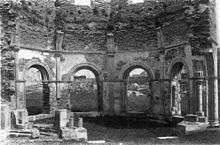Mellifont Abbey
Mellifont Abbey (Irish: An Mhainistir Mhór, literally 'the Big Monastery'), was a Cistercian abbey located close to Drogheda in County Louth, Ireland. It was the first abbey of the order to be built in Ireland. In 1152, it hosted the Synod of Kells-Mellifont. After its dissolution in 1539 the abbey became a private manor house. This saw the signing of the Treaty of Mellifont in 1603 and served as William of Orange's headquarters in 1690 during the Battle of the Boyne.
An Mhainistir Mhór | |
Lavabo of Mellifont Abbey | |
 Location within Ireland | |
| Monastery information | |
|---|---|
| Order | Cistercians |
| Established | 1142 |
| Disestablished | 1539 |
| Reestablished | 1938 (different location) |
| Diocese | Armagh |
| People | |
| Founder(s) | Saint Malachy, Archbishop of Armagh |
| Architecture | |
| Status | Active |
| Style | Cistercian |
| Site | |
| Location | Collon, County Louth, Ireland |
| Coordinates | 53.742317°N 6.466481°W |
| Public access | Yes |
National Monument of Ireland | |
| Reference no. | 93[1] |
Today, the ruined abbey is a National monument of Ireland and accessible to the public. The English language name for the monastery, 'Mellifont', comes from the Latin phrase Melli-fons, meaning 'Font of Honey'.
Location
Mellifont Abbey sits on the banks of the River Mattock, some 10 km (6 miles) north-west of Drogheda.
History
Origins


The abbey was founded in 1142 on the orders of Saint Malachy, Archbishop of Armagh.[2] By 1170, Mellifont had one hundred monks and three hundred lay brothers. The abbey became the model for other Cistercian abbeys built in Ireland, with its formal style of architecture imported from the abbeys of the same order in France; it was the main abbey in Ireland until its dissolution.
The Synod of 1152
An important synod was held in Mellifont in 1152 as recorded in the Annals of the Four Masters, which states that the synod was attended by bishops and kings along with the Papal Legate, Giovanni Cardinal Paparoni (also known as John Cardinal Paparo; Saint Malachy had died some four years earlier). The consecration of the church took place in 1157 and asserted Church authority by banishing the King of Meath, Donnchadh Ua Maeleachlainn.
Various kings gave donations to assist this foundation: Muirchertach Ua Lochlainn, provincial king of Ulster, gave cattle, some gold and also a local town land, Donnchad Ua Cearbhall, the king of Airgialla (Oriel), who had donated the land, also gave gold, while Derbforgaill, the wife of Tigernan Ua Ruairc gave gold, a chalice and altar cloths.
After dissolution
The abbey was dissolved in 1539, when it became a fortified house.
In 1603 the Treaty of Mellifont was agreed between the English Crown and Hugh O'Neill, Earl of Tyrone, in the abbey grounds. Mellifont was then the property of The 1st Viscount Moore, who was a close friend of Lord Tyrone, and helped persuade him to sign the Treaty. The Moore family, who later became Earls of Drogheda, remained the owners of Mellifont until 1727.
William of Orange used Mellifont Abbey House as his headquarters during the Battle of the Boyne in 1690.
Description
Mellifont Abbey is now a ruin. Little of the original abbey remains, save a 13th-century lavabo (where the monks washed their hands before eating), some Romanesque arches and a 14th-century chapter house.
Burials
New Mellifont Abbey
New Mellifont Abbey is home to the cistercian monks and is located in Collon, a small village and townland in the south west corner of County Louth, on the N2 national primary road.
See also
- List of abbeys and priories in Ireland (County Louth)
References
- "National Monuments in State Care: Ownership & Guardianship, Louth" (PDF). 4 March 2009. Retrieved 25 January 2018.
- "Old Mellifont Abbey", Heritage Ireland
External links
| Wikimedia Commons has media related to Mellifont Abbey. |
- The Boyne Valley Tourist Portal - Info on and images of Old Mellifont Abbey
- Herbermann, Charles, ed. (1913). . Catholic Encyclopedia. New York: Robert Appleton Company.
- Mellifont Abbey, Co. Louth: Its Ruins and Associations, a Guide and Popular History at Project Gutenberg
 | |